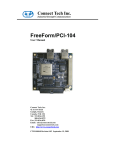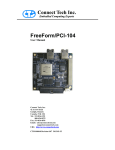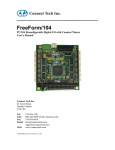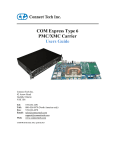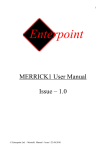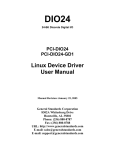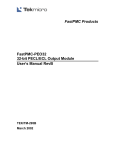Download Connect Tech 104 Network Card User Manual
Transcript
FreeForm/PCI-104 User Manual Connect Tech, Inc. 42 Arrow Road Guelph, Ontario Canada, N1K 1S6 Tel: 519-836-1291 800-426-8979 Fax: 519-836-4878 Email: [email protected] [email protected] URL: http://www.connecttech.com CTIM-00040 Revision 0.00 January 28, 2008 Connect Tech FreeForm/PCI-104 User Manual Limited Lifetime Warranty Connect Tech Inc. provides a Lifetime Warranty for all Connect Tech Inc. products. Should this product, in Connect Tech Inc.'s opinion, fail to be in good working order during the warranty period, Connect Tech Inc. will, at its option, repair or replace this product at no charge, provided that the product has not been subjected to abuse, misuse, accident, disaster or non Connect Tech Inc. authorized modification or repair. You may obtain warranty service by delivering this product to an authorized Connect Tech Inc. business partner or to Connect Tech Inc. along with proof of purchase. Product returned to Connect Tech Inc. must be pre-authorized by Connect Tech Inc. with an RMA (Return Material Authorization) number marked on the outside of the package and sent prepaid, insured and packaged for safe shipment. Connect Tech Inc. will return this product by prepaid ground shipment service. The Connect Tech Inc. Lifetime Warranty is defined as the serviceable life of the product. This is defined as the period during which all components are available. Should the product prove to be irreparable, Connect Tech Inc. reserves the right to substitute an equivalent product if available or to retract Lifetime Warranty if no replacement is available. The above warranty is the only warranty authorized by Connect Tech Inc. Under no circumstances will Connect Tech Inc. be liable in any way for any damages, including any lost profits, lost savings or other incidental or consequential damages arising out of the use of, or inability to use such product. Copyright Notice The information contained in this document is subject to change without notice. Connect Tech Inc. shall not be liable for errors contained herein or for incidental consequential damages in connection with the furnishing, performance, or use of this material. This document contains proprietary information that is protected by copyright. All rights are reserved. No part of this document may be photocopied, reproduced, or translated to another language without the prior written consent of Connect Tech, Inc. Copyright © 2008 by Connect Tech, Inc. Trademark Acknowledgment Connect Tech, Inc. acknowledges all trademarks, registered trademarks and/or copyrights referred to in this document as the property of their respective owners. Not listing all possible trademarks or copyright acknowledgments does not constitute a lack of acknowledgment to the rightful owners of the trademarks and copyrights mentioned in this document. Revision 0.00 2 Connect Tech FreeForm/PCI-104 User Manual Customer Support Overview If you experience difficulties after reading the manual and/or using the product, contact the Connect Tech reseller from which you purchased the product. In most cases the reseller can help you with product installation and difficulties. In the event that the reseller is unable to resolve your problem, our highly qualified support staff can assist you. Our support section is available 24 hours a day, seven days a week on our website at: www.connecttech.com/support/support.asp. See the contact information section below for more information on how to contact us directly. Our technical support is always free. Not listing all possible trademarks or copyright acknowledgments does not constitute a lack of acknowledgment to the rightful owners of the trademarks and copyrights mentioned in this document. Contact Information We offer three ways for you to contact us: Telephone/Facsimile Technical Support representatives are ready to answer your call Monday through Friday, from 8:30 a.m. to 5:00 p.m. Eastern Standard Time. Our numbers for calls are: Telephone: Telephone: Facsimile: 800-426-8979 (North America only) 519-836-1291 (Live assistance available 8:30 a.m. to 5:00 p.m. EST, Monday to Friday) 519-836-4878 (on-line 24 hours) Email/Internet You may contact us through the Internet. Our email and URL addresses are: [email protected] [email protected] www.connecttech.com Mail/Courier You may contact us by letter and our mailing address for correspondence is: Connect Tech, Inc. 42 Arrow Road Guelph, Ontario Canada N1K 1S6 Revision 0.00 3 Connect Tech FreeForm/PCI-104 User Manual Table of Contents Limited Lifetime Warranty......................................................................................................... 2 Copyright Notice ........................................................................................................................ 2 Trademark Acknowledgment ..................................................................................................... 2 Customer Support Overview ...................................................................................................... 3 Contact Information ........................................................................................................... 3 Table of Contents ....................................................................................................................... 4 List of Tables.............................................................................................................................. 5 List of Figures ............................................................................................................................ 5 Introduction ................................................................................................................................ 6 Features.............................................................................................................................. 6 Hardware Description and Configuration................................................................................... 8 Jumpers and Switches ........................................................................................................ 8 Slot Selection (RSW1) .............................................................................................. 8 FPGA Configuration Settings (J1) ............................................................................ 8 Connector Pinouts.............................................................................................................. 9 PCI-104 Header (P1) ................................................................................................. 9 JTAG Programming Header (P2).............................................................................. 9 SPI Flash Programming Header (P3) ........................................................................ 9 RS-485 Headers (P5, P6)......................................................................................... 10 External Power Connector (P8)............................................................................... 10 GPIO Header (P7) ................................................................................................... 11 Hardware Installation ............................................................................................................... 12 Standalone Operation....................................................................................................... 12 Software Installation................................................................................................................. 12 FPGA Development Environment ................................................................................... 12 Drivers and Application Examples .................................................................................. 12 FPGA Configuration ................................................................................................................ 13 Launch Impact ................................................................................................................. 13 Programming the FPGA .................................................................................................. 16 Generating a PROM (MCS) File ..................................................................................... 17 Configuring the FPGA with the SPI Flash....................................................................... 20 Configuring the FPGA / SPI flash Association ....................................................... 20 Programming the Flash ........................................................................................... 22 Reference Design ..................................................................................................................... 24 Functionality .................................................................................................................... 24 Memory Map ................................................................................................................... 24 Implementation ................................................................................................................ 25 Specifications ........................................................................................................................... 26 Revision 0.00 4 Connect Tech FreeForm/PCI-104 User Manual List of Tables Table 1: FreeForm/PCI-104 Components .................................................................................. 7 Table 2: Slot Selection (RSW1) ................................................................................................. 8 Table 3: FPGA Configuration Settings (J1) ............................................................................... 8 Table 4: JTAG Programming Header Pinout (P2)...................................................................... 9 Table 5: SPI Flash Programming Header Pinout (P3) ................................................................ 9 Table 6: RS-485 Port 1 Pinout (P5).......................................................................................... 10 Table 7: RS-485 Port 2 Pinout (P6).......................................................................................... 10 Table 8: External Power Connector Pinout (P8) ...................................................................... 10 Table 9: GPIO Header Pinout................................................................................................... 11 Table 10: Bar Local Address Space 0 (Bar 2) .......................................................................... 24 Table 11: Local Address Space 1 (Bar 3)................................................................................. 25 List of Figures Figure 1: FreeForm/PCI-104 Block Diagram............................................................................. 6 Figure 2: FreeForm/PCI-104 Layout .......................................................................................... 7 Figure 3: External Power Connection....................................................................................... 10 Revision 0.00 5 Connect Tech FreeForm/PCI-104 User Manual Introduction Connect Tech’s FreeForm/PCI-104 features Xilinx’s Virtex-5 multi-platform FPGA offering users a flexible, reconfigurable product that also takes advantage of the high bandwidth capabilities of the PCI bus while communicating with various I/O interfaces. Features o o o o o o o o o o o o PCI-104 form factor – 32-Bit/33MHz Xilinx multi-platform Virtex-5 FPGA with 3 million logic gates 8MB Flash for embedded code storage Designed for embedded processing using MicroBlaze™ 100MHz input clock 128MB DDR2-400 memory External 5V power connection for stand alone usage 2 x 10/100 Ethernet with modular jacks 2 x RS-485 serial interface On-board reset switch 64 single ended or 32 LVDS general purpose I/O Available in industrial temperature range of -40°C to 85° Figure 1: FreeForm/PCI-104 Block Diagram Revision 0.00 6 Connect Tech FreeForm/PCI-104 User Manual Figure 2: FreeForm/PCI-104 Layout Table 1: FreeForm/PCI-104 Components Connectors P1 P2 P3 P5, P6 P7 P8 P9 P10 Jumpers /Switches RSW1 J1 Components D1-D4 D5 U4 U5 U10 U11 U12, U13 U14 U15, U16 U17 O1 Revision 0.00 Description PCI-104 connector JTAG programming header SPI flash programming header RS-485 header GPIO header External power header RJ-45 A RJ-45 B Description Slot selection FPGA configuration settings Description User LEDs FPGA load complete LED PLX PCI-local bus bridge Virtex-5 FPGA FPGA configuration flash Embedded code flash DDR2 memory Parameter EEPROM RS-485 transceiver Dual 10/100 PHY 100MHz oscillator, main clock 7 Connect Tech FreeForm/PCI-104 User Manual Hardware Description and Configuration The following sections describe the function of all switches/jumpers and provide details on connector pinouts. Jumpers and Switches Slot Selection (RSW1) This rotary switch selects a slot position in the PCI-104 stack. When mounting on a PCI adapter card, ensure slot one is selected. Table 2: Slot Selection (RSW1) Position Slot 0,4 0 1,5 1 2,6 2 3,7 3 FPGA Configuration Settings (J1) Jumper J1 is used to control FPGA configuration. Table 3: FPGA Configuration Settings (J1) FPGA waits for configuration over JTAG, using the cable it is connected to FPGA reads configuration from SPI flash FPGA is tri-state, program flash directly Revision 0.00 8 Connect Tech FreeForm/PCI-104 User Manual Connector Pinouts PCI-104 Header (P1) Refer to PCI-104 specifications. Note: P1 must be connected to a PCI-104 stack supplying both 3.3V and 5V JTAG Programming Header (P2) Use P2 to configure the FPGA via JTAG. Refer to Programming the FPGA for more information. Power pins are for voltage reference only; they do not provide power to the configuration circuitry. Note that the FPGA can always be programmed via JTAG, regardless of the J1 configuration setting. Table 4: JTAG Programming Header Pinout (P2) Pin 1 2 3 4 5 6 7 Signal TRST TMS TDI TDO TCK GND 3.3V Direction Input Input Input Output Input Reference Reference SPI Flash Programming Header (P3) P3 may be used to directly program the SPI flash, providing that J1 is set correctly to the tri-state FPGA position. The power pins are for voltage reference only. They do not provide power to the configuration circuitry. Table 5: SPI Flash Programming Header Pinout (P3) Pin Signal Direction 1 SPI_CSN Input 2 SPI_MOSI Input 3 SPI_MISO Output 4 SPI_CLK Input 5 GND Reference 6 3.3V Reference Revision 0.00 9 Connect Tech FreeForm/PCI-104 User Manual RS-485 Headers (P5, P6) Table 6: RS-485 Port 1 Pinout (P5) Table 7: RS-485 Port 2 Pinout (P6) Pin 1 2 3 4 5 6 7 8 9 10 Pin 1 2 3 4 5 6 7 8 9 10 Signal RXD+1 Direction Input RXD-1 Input TXD+1 Output TXD-1 Output GND power Signal RXD+2 Direction Input RXD-2 Input TXD+2 Output TXD-2 Output GND power External Power Connector (P8) The external connector provides 5V to the power regulation circuitry. In addition, the power connector enables the 3.3V regulator and provides VIO to the PCI Bridge. The external power connector should only be used when the FreeForm/PCI-104 is being programmed out side of a PCI / PCI-104 system. Table 8: External Power Connector Pinout (P8) Pin 1 2 3 4 Signal 5V 3.3 enable (connect to 5V) VIO (connect to 5V) GND Direction Power Input Power Power It is recommended that a Connect Tech Inc. FreeForm/PCI-104 power supply is used. Orientation of the power supply connector is important. Ensure that the clip on the cable aligns with the catch on P8, as shown below. Figure 3: External Power Connection Revision 0.00 10 Connect Tech FreeForm/PCI-104 User Manual GPIO Header (P7) The GPIO header has been design such that when in differential mode, the positive (P) and negative (N) signals are adjacent on a standard ribbon cable. Note that the GPIO voltage level is set via hardware. FCG001: has L12 populated, enabling 2.5V I/O, including LVDS FCG002: has L13 populated, enabling 3.3V I/O Pin 1 2 3 4 5 6 7 8 9 10 11 12 13 14 15 16 17 18 19 20 21 22 23 24 25 26 27 28 29 30 31 32 33 34 35 36 37 38 39 40 Revision 0.00 Signal GPION(0) GPIOP(0) GPION(1) GPIOP(1) GPION(2) GPIOP(2) GPION(3) GPIOP(3) GND GND GPION(4) GPIOP(4) GPION(5) GPIOP(5) GPION(6) GPIOP(6) GPION(7) GPIOP(7) GND GND GPION(8) GPIOP(8) GPION(9) GPIOP(9) GPION(10) GPIOP(10) GPION(11) GPIOP(11) GND GND GPION(12) GPIOP(12) GPION(13) GPIOP(13) GPION(14) GPIOP(14) GPION(15) GPIOP(15) GND GND Table 9: GPIO Header Pinout Direction Pin Signal Input/Output 41 GPION(16) Input/Output 42 GPIOP(16) Input/Output 43 GPION(17) Input/Output 44 GPIOP(17) Input/Output 45 GPION(18) Input/Output 46 GPIOP(18) Input/Output 47 GPION(19) Input/Output 48 GPIOP(19) power 49 GND Power 50 GND Input/Output 51 GPION(20) Input/Output 52 GPIOP(20) Input/Output 53 GPION(21) Input/Output 54 GPIOP(21) Input/Output 55 GPION(22) Input/Output 56 GPIOP(22) Input/Output 57 GPION(23) Input/Output 58 GPIOP(23) Power 59 GND Power 60 GND Input/Output 61 GPION(24) Input/Output 62 GPIOP(24) Input/Output 63 GPION(25) Input/Output 64 GPIOP(25) Input/Output 65 GPION(26) Input/Output 66 GPIOP(26) Input/Output 67 GPION(27) Input/Output 68 GPIOP(27) Power 69 GND Power 70 GND Input/Output 71 GPION(28) Input/Output 72 GPIOP(28) Input/Output 73 GPION(29) Input/Output 74 GPIOP(29) Input/Output 75 GPION(30) Input/Output 76 GPIOP(30) Input/Output 77 GPION(31) Input/Output 78 GPIOP(31) Power 79 GND power 80 GND Direction Input/Output Input/Output Input/Output Input/Output Input/Output Input/Output Input/Output Input/Output Power Power Input/Output Input/Output Input/Output Input/Output Input/Output Input/Output Input/Output Input/Output Power Power Input/Output Input/Output Input/Output Input/Output Input/Output Input/Output Input/Output Input/Output Power Power Input/Output Input/Output Input/Output Input/Output Input/Output Input/Output Input/Output Input/Output Power Power 11 Connect Tech FreeForm/PCI-104 User Manual Hardware Installation Before installing the FreeForm/PCI-104 into a PC/104 stack, ensure the following: o o Slot selection properly set using the rotary switch RSW1. Note that the FreeForm/PCI-104 address space consumes 32 bytes. FPGA configuration jumper J1 is set to read from Flash Once installed in the system and power is applied, the LED D1 will illuminate to indicate that FreeForm/PCI-104 is functioning properly. Standalone Operation Operating the FreeForm/PCI-104 outside of a PCI-104 stack or a PCI system for extended periods of time is not recommended. The PCI to local bus bridge (PLX 9056) requires the pull-up / pull-down resistors provided on a system main board. Configuring / programming the FreeForm/PCI-104 in standalone mode is acceptable, providing it is not left powered in that state. Software Installation FPGA Development Environment FreeForm/PCI-104 has been developed with Xilinx WebPACK 9.2, available free of charge at: http://www.xilinx.com/ise/logic_design_prod/webpack.htm Drivers and Application Examples The FreeForm/PCI-104 ships with a CD containing drivers for various operating systems and example programs to help quickly develop applications. Refer to the CD for installation instructions. For other operating systems, please check the Connect Tech website’s download zone: http://www.connecttech.com/asp/Support/DownloadZone.asp Revision 0.00 12 Connect Tech FreeForm/PCI-104 User Manual FPGA Configuration To configure the FPGA via JTAG, connect the JTAG programming cable to P2 ensuring that all JTAG signals align correctly. It is important to note that P2 also has the TRST signal on pin 1, which is not part of Xilinx’s Parallel or USB programming cables. Launch Impact 1) Open iMPACT, and select create a new project 2) Select configure devices using boundary scan. iMPACT will scan the JTAG chain, and identify three devices. The first device will be the FPGA. Revision 0.00 13 Connect Tech FreeForm/PCI-104 User Manual 3) A prompt will ask for a new configuration file. Select the bitstream from the project directory. 4) A prompt will ask for a BSDL file for device number 2 (PLX PCI9056). Click Yes. 5) Browse to the bsdl folder and select PCI9056BA.bsd Revision 0.00 14 Connect Tech FreeForm/PCI-104 User Manual 6) iMPACT will add the device to the JTAG chain. 7) Again, a prompt will ask for device number three (National PHY). Browse to the bsdl folder and select DP83849IVS.bsd. The device will be added to the JTAG chain. 8) To test stream integrity, right click on the FPGA and select Get Device ID. The console will report IDCODE = 82a6e093 Revision 0.00 15 Connect Tech FreeForm/PCI-104 User Manual Programming the FPGA 1) Right click on device number one (Virtex-5 FPGA), and select program. The following diagram will appear. Note that verification will only work if an msk file has been created. 2) Select OK to begin programming. After programming is complete, the status window will report: Revision 0.00 16 Connect Tech FreeForm/PCI-104 User Manual Generating a PROM (MCS) File 1) Double click Prom File Formatter in the Flows window. 2) The “Prepare PROM Files” dialog will appear. Ensure that the following settings are selected: 3rd Party SPI PROM MSC PROM File Format 3) Give the file a name, and click Next. Revision 0.00 17 Connect Tech FreeForm/PCI-104 User Manual 4) Select the PROM density (16M) → click Next → click Finish. 5) A prompt will ask to add device to data stream 0. Click OK. Select the bitstream from the project directory. Revision 0.00 18 Connect Tech FreeForm/PCI-104 User Manual 6) Click “No” when asked if another device is to be added. Click “OK” to accept the setup. 7) Double Click “Generate File” from the “iMPACT” processes menu. The status will be reported in the console. // *** BATCH CMD : setMode -pff // *** BATCH CMD : setSubmode -pffparallel // *** BATCH CMD : setAttribute -configdevice -attr fillValue -value "FF" // *** BATCH CMD : setAttribute -configdevice -attr swapBit -value "true" // *** BATCH CMD : setAttribute -configdevice -attr fileFormat -value "mcs" // *** BATCH CMD : setAttribute -configdevice -attr dir -value "UP" // *** BATCH CMD : setAttribute -configdevice -attr path -value "C:\Data\Projects\FreeFormPCI104\hardware\logic\init_plx_GPIO25\/" // *** BATCH CMD : setAttribute -configdevice -attr name -value "init_plx_GPIO25.cs" Total configuration bit size = 9371136 bits. Total configuration byte size = 1171392 bytes. // *** BATCH CMD : setCurrentDesign -version 0 // *** BATCH CMD : generate -spi Swap bit can only be disabled in Hex file format only. 0x11dfc0 (1171392) bytes loaded up from 0x0 Using user-specified prom size of 2048K Writing file "C:\Data\Projects\FreeFormPCI104\hardware\logic\init_plx_GPIO25\//init_plx_GPIO25.mcs" . Writing file "C:\Data\Projects\FreeFormPCI104\hardware\logic\init_plx_GPIO25\//init_plx_GPIO25.prm" . Revision 0.00 19 Connect Tech FreeForm/PCI-104 User Manual Configuring the FPGA with the SPI Flash In previous Xilinx FPGA configurations, the SPI flash would require programming via 3rd party JTAG test software or through in-system methods. The following features are new to ISE 9.1/9.2, and are only available on select FPGAs, including the Virtex-5. Your FreeForm/PCI-104 card featuring the Xilinx Virtex-5 FPGA includes a standard core to enable programming of BPI and SPI flashes over JTAG. Configuring the FPGA / SPI flash Association 1) Select “Boundary Scan” from the “Flows” tab. 2) Right click on the FPGA and select “Add SPI Flash…” Revision 0.00 20 Connect Tech FreeForm/PCI-104 User Manual 3) Browse to the directory containing the previously generated MCS file. Select and click “Open”. 4) The “FPGA SPI Flash Association” window will appear; select “M25P16” (this is the flash device connected to the FPGA). 5) The flash will be added to the FPGA. Note that this flash is not part of the JTAG chain. Revision 0.00 21 Connect Tech FreeForm/PCI-104 User Manual Programming the Flash 1) Right click the previously associated flash device, and select program. 2) The programming dialog will appear. Select “Verify” and “Erase Before Programming”, then click OK. Revision 0.00 22 Connect Tech FreeForm/PCI-104 User Manual 3) Observe the results in the transcript window. a. The SPI core is first download to the FPGA device b. The IDCODE is checked and verified c. Flash is erased d. Flash is programmed After completion of the flash programming, the FPGA will attempt to configure itself from the flash. If the SPI flash setting is not selected with J1; this step will fail. This does not mean the flash is not programmed, but rather the verification of the programmed contents has failed. '1': SPI access core not detected. SPI access core will be downloaded to the device to enable operations. PROGRESS_START - Starting Operation. '1': Downloading core... done. '1': Reading status register contents... INFO:iMPACT:2219 - Status register values: INFO:iMPACT - 0011 1111 1001 1110 0000 1010 1000 0000 INFO:iMPACT:2492 - '1': Completed downloading core to device. INFO:iMPACT - '1': Checking done pin....done. '1': Core downloaded successfully. '1': IDCODE is '202015' (in hex). '1': ID Check passed. '1': IDCODE is '202015' (in hex). '1': ID Check passed. '1': Erasing Device. '1': Programming Device. '1': Reading device contents... done. '1': Verification completed. INFO:iMPACT - '1': Checking done pin....done. '1': Programmed successfully. INFO:iMPACT - '1': Checking done pin....done. '1': Programmed successfully. PROGRESS_END - End Operation. Elapsed time = 179 sec. Revision 0.00 23 Connect Tech FreeForm/PCI-104 User Manual Reference Design The FreeForm/PCI-104 ships with a pre-installed reference design. This reference design demonstrates how the FPGA interacts with the PLX 9056 PLX to local bus bridge. Functionality o o o o o o Local bus interface driven at 50MHz Slave access to: o BAR2: 16x32 bit control registers , 16x32 bit user memory o BAR3: SPI flash programming interface Master access to same 16x32 user memory as located in BAR2. Transfer controlled through slave accessible registers. Local bus master configuration of bridge (happens automatically with reset). Single-ended GPIO control through registers. LED control through registers. Memory Map Table 10: Bar Local Address Space 0 (Bar 2) Local Address (HEX) Contents Access Description 00000000 INTERRUPT_MASK R/W Bit 0: Direct master state machine Bit 1: SPI programmer 00000004 INTERRUPT_SOURCE R Bit 0: Direct master state machine Bit 1: SPI programmer 00000008 REG2 R/W UNUSED 0000000C REG3 R/W UNUSED 00000010 GPIO_P_OUT W Each bit corresponds to one GPIO pin output. Direction must be set to output 00000014 GPIO_P_TRI W Each bit corresponds to one GPIO pin direction (1=Output) 00000018 GPIO_P_IN R Each bit corresponds to one GPIO pin input 0000001C GPIO_N_OUT W Same as GPIO_N_OUT 00000020 GPIO_N_TRI W Same as GPIO_N_TRI 00000024 GPIO_N_IN R Same as GPIO_N_IN 00000028 DM_STATE R Bits correspond to direct master states, refer to plx32master.vhd for more details 0000002C USER_LED W Bit 0: Led 1 Bit 1: Led 2 Bit 2: Led 3 Bit 3: Led 4 00000030 DM_CTRL W Bit 0: start operation, when complete must be cleared before another operation can begin Bit 1: Write = 1, Read = 0 00000034 DM_ADDR W Local bus destination address. Must match what is programmed into PLX configuration register DMLBAM. 00000038 DM_CNT W Number of DWORDs to transfer 0000003C REVISION R/W Reference design revision R/W User Memory Bit #: GPIO_P(#) Bit #: GPIO_P(#) 00000040 – 0000007C Revision 0.00 24 Connect Tech FreeForm/PCI-104 User Manual Table 11: Local Address Space 1 (Bar 3) Local Address Contents Access Description 10000000 SPI Command RW SPI controller command register, once command is written operation begins 10000004 SPI Parameters RW There are four parameters, each one byte - 0x04: Param0 - 0x05: Param1 - 0x06: Param2 - 0x07: Param3 10000008 SPI Status R SPI controller status register - Bit 0: Operation complete 1000000C SPI Result R There are four results, each one byte - 0x04: Result0 - 0x05: Result1 - 0x06: Result2 - 0x07: Result3 10000010 – 100000FC Un addressable N/A N/A 10000100 – 100001FC Dual port memory RW 256 Bytes of for flash page storage Implementation Refer to the FreeForm/PCI-104 VHDL Reference Design Application Note for further information. Revision 0.00 25 Connect Tech FreeForm/PCI-104 User Manual Specifications Programmable FPGA Virtex-5 FPGA LX30T Input Clock 100MHz Memory 8MB Flash, 128MB DDR2-400 General Purpose User I/O 64 single ended I/O 32 LVDS I/O Serial 2 x RS-485 Ethernet 2 x 10Base-T, 100Base-TX Operating Environment Storage Temperature: -65°C to 150°C Operating Temperature: 0°C to 70°C -40°C to 85°C Power Requirements (commercial) (industrial) +3.3V DC and +5V DC, in PCI-104 stack +5V DC standalone Current requirements are configuration dependant Dimensions PC/104-Plus 2.2 compliant PCI-104 1.0 compliant Connectors Two RJ-45 modular jacks (Ethernet) Two 2x5 0.100” headers (serial) One 2x40 0.050 x 0.100” header (general I/O) One 1x6 0.100” header (flash programming) Revision 0.00 26


























